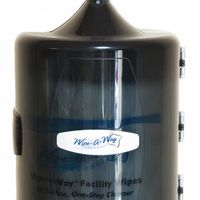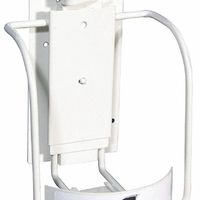Call +(254) 703 030 000 / 751 483 999 / 721 704 777
- Home
- Cleaning And Janitorial
- Cleaning Supplies
- Wipe Dispensers
.....Read More
Frequently Asked Questions
What are the benefits of using wipe dispensers in the workplace?
Wipe dispensers in the workplace offer numerous benefits, enhancing hygiene, efficiency, and convenience. Firstly, they promote a healthier environment by providing easy access to disinfectant wipes, which help reduce the spread of germs and bacteria. This is crucial in preventing illnesses, thereby reducing employee absenteeism and maintaining productivity.
Secondly, wipe dispensers encourage regular cleaning habits. When wipes are readily available, employees are more likely to clean their workspaces frequently, leading to a consistently tidy and organized environment. This not only improves the overall appearance of the workplace but also boosts employee morale and satisfaction.
Thirdly, wipe dispensers are cost-effective. By minimizing the spread of infections, they can lead to fewer sick days and lower healthcare costs for the company. Additionally, they reduce the need for professional cleaning services, as employees can easily maintain cleanliness themselves.
Moreover, wipe dispensers are versatile and can be used on various surfaces, including desks, keyboards, and communal areas like break rooms and restrooms. This versatility ensures that all areas of the workplace remain clean and hygienic.
Furthermore, they are user-friendly and require minimal maintenance. Most dispensers are designed for easy refilling and use, ensuring that employees can quickly grab a wipe without any hassle. This convenience saves time and allows employees to focus on their tasks.
Lastly, wipe dispensers contribute to environmental sustainability when stocked with biodegradable or eco-friendly wipes. This aligns with corporate social responsibility goals and demonstrates a commitment to environmental stewardship.
In summary, wipe dispensers enhance workplace hygiene, promote regular cleaning, are cost-effective, versatile, user-friendly, and support sustainability efforts, making them a valuable addition to any workplace.
How do dry wipe dispensers differ from wet wipe dispensers?
Dry wipe dispensers and wet wipe dispensers differ primarily in their design, purpose, and the type of wipes they dispense.
Dry wipe dispensers are designed to hold and dispense dry wipes, which are typically made of materials like paper or non-woven fabric. These wipes are used for tasks such as dusting, cleaning surfaces, or wiping hands when moisture is not required. The dispensers are often simple in design, focusing on keeping the wipes dry and easily accessible. They may be wall-mounted or portable, and often feature a mechanism to pull out one wipe at a time to prevent waste.
Wet wipe dispensers, on the other hand, are specifically designed to hold pre-moistened wipes. These wipes are saturated with a cleaning solution, disinfectant, or other liquid, making them suitable for sanitizing surfaces, personal hygiene, or cleaning up spills. The dispensers for wet wipes are typically sealed to prevent the wipes from drying out. They often include a lid or a resealable opening to maintain moisture and hygiene. Wet wipe dispensers can be found in various settings, including healthcare facilities, gyms, and households, and are available in wall-mounted, tabletop, or portable formats.
In summary, the key differences lie in the type of wipes they dispense (dry vs. wet), the design features to maintain the wipes' condition (dryness vs. moisture), and their intended use cases (general cleaning vs. sanitizing or personal hygiene).
Where are dry wipe dispensers commonly used?
Dry wipe dispensers are commonly used in various settings where cleanliness and hygiene are prioritized. These include:
1. **Healthcare Facilities**: Hospitals, clinics, and dental offices use dry wipe dispensers for quick and efficient cleaning of surfaces to prevent the spread of infections.
2. **Educational Institutions**: Schools and universities utilize them in classrooms and laboratories for maintaining cleanliness on whiteboards and other surfaces.
3. **Offices**: Corporate environments use dry wipe dispensers for cleaning whiteboards during meetings and maintaining general office cleanliness.
4. **Hospitality Industry**: Hotels and restaurants use them for quick clean-ups in dining areas, kitchens, and guest rooms to ensure a hygienic environment.
5. **Retail Stores**: Supermarkets and retail outlets place them at entrances and exits for customers to clean their hands or shopping carts.
6. **Industrial Settings**: Factories and workshops use them for cleaning machinery and workstations to maintain a safe and clean working environment.
7. **Public Transportation**: Airports, train stations, and buses use them for cleaning seats, handrails, and other high-touch areas to enhance passenger safety.
8. **Gyms and Fitness Centers**: They are used for wiping down equipment and mats to maintain hygiene and prevent the spread of germs.
9. **Food Processing Plants**: These facilities use dry wipe dispensers to ensure surfaces are clean and free from contaminants.
10. **Laboratories**: Research and testing labs use them for cleaning surfaces and equipment to maintain a sterile environment.
In all these settings, dry wipe dispensers help in maintaining hygiene, ensuring quick and easy access to cleaning materials, and promoting a clean and safe environment.
What types of facilities typically use wet wipe dispensers?
Wet wipe dispensers are commonly used in a variety of facilities to promote hygiene and convenience. These facilities include:
1. **Healthcare Facilities**: Hospitals, clinics, and nursing homes use wet wipe dispensers for patient care, sanitation, and infection control.
2. **Gyms and Fitness Centers**: To maintain cleanliness, gyms provide wet wipe dispensers for users to wipe down equipment after use.
3. **Schools and Daycares**: These institutions use wet wipe dispensers to ensure the cleanliness of surfaces and the hygiene of children.
4. **Offices and Corporate Buildings**: Wet wipe dispensers are placed in restrooms and common areas to encourage employee hygiene and maintain a clean environment.
5. **Restaurants and Food Service Areas**: To ensure food safety and cleanliness, wet wipe dispensers are used for cleaning surfaces and for customer use.
6. **Retail Stores and Shopping Malls**: These facilities use wet wipe dispensers to offer customers a way to clean their hands and shopping carts.
7. **Airports and Public Transportation**: To manage high traffic and maintain hygiene, wet wipe dispensers are available for travelers.
8. **Hotels and Hospitality Venues**: Wet wipe dispensers are provided in guest rooms and common areas for personal hygiene and surface cleaning.
9. **Industrial and Manufacturing Facilities**: These facilities use wet wipe dispensers to clean equipment and maintain worker hygiene.
10. **Event Venues and Stadiums**: To accommodate large crowds, wet wipe dispensers are used to promote hygiene and cleanliness.
11. **Spas and Salons**: These establishments use wet wipe dispensers for client hygiene and to clean tools and surfaces.
12. **Public Restrooms**: Wet wipe dispensers are commonly found in public restrooms to enhance hygiene and convenience for users.
How do wet wipe dispenser accessories help maintain cleanliness?
Wet wipe dispenser accessories play a crucial role in maintaining cleanliness by ensuring that wipes are easily accessible, properly stored, and effectively used. These accessories include wall-mounted dispensers, floor stands, and tabletop holders, each designed to facilitate the convenient distribution of wipes in various settings such as homes, offices, gyms, and healthcare facilities.
Firstly, these dispensers help in organizing and storing wet wipes in a manner that prevents contamination. By keeping wipes enclosed, they protect them from dust, dirt, and other environmental contaminants, ensuring that each wipe is clean and ready for use. This is particularly important in high-traffic areas where hygiene is a priority.
Secondly, dispenser accessories promote efficient usage of wipes. By dispensing one wipe at a time, they minimize waste and ensure that users do not inadvertently touch other wipes, which could lead to cross-contamination. This controlled dispensing mechanism is essential in maintaining hygiene standards, especially in public or shared spaces.
Moreover, the strategic placement of dispensers encourages regular use. When wipes are readily available and visible, individuals are more likely to use them to clean surfaces, hands, or equipment, thereby reducing the spread of germs and bacteria. This is particularly beneficial in environments like gyms or hospitals, where frequent cleaning is necessary to maintain a sanitary environment.
Additionally, some dispensers come with features like antimicrobial coatings or touchless operation, further enhancing their role in promoting cleanliness. These features reduce the risk of germ transfer and make the process of obtaining a wipe more hygienic.
In summary, wet wipe dispenser accessories are essential tools in maintaining cleanliness by ensuring proper storage, promoting efficient use, and encouraging regular cleaning practices, thereby contributing to a healthier and more hygienic environment.
What factors should be considered when choosing a wipe dispenser?
When choosing a wipe dispenser, several factors should be considered to ensure it meets your needs effectively:
1. **Type of Wipes**: Determine whether the dispenser is compatible with the type of wipes you plan to use, such as disinfectant, baby, or industrial wipes.
2. **Capacity**: Consider the dispenser's capacity to ensure it can hold an adequate number of wipes for your usage frequency, reducing the need for frequent refills.
3. **Material and Durability**: Choose a dispenser made from durable materials like stainless steel or high-quality plastic, especially for high-traffic areas, to withstand wear and tear.
4. **Ease of Use**: Ensure the dispenser allows for easy loading and dispensing of wipes. It should be user-friendly for both staff and customers.
5. **Mounting Options**: Decide if you need a wall-mounted, countertop, or freestanding dispenser based on the available space and convenience.
6. **Design and Aesthetics**: Consider the design and color of the dispenser to ensure it complements the environment where it will be placed.
7. **Hygiene Features**: Look for features that promote hygiene, such as touchless dispensing or antimicrobial surfaces, to minimize the spread of germs.
8. **Cost**: Evaluate the cost of the dispenser in relation to your budget, including any ongoing costs for maintenance or replacement parts.
9. **Brand and Reviews**: Research brands and read reviews to ensure reliability and customer satisfaction with the dispenser's performance.
10. **Refill Availability**: Ensure that refills for the dispenser are readily available and cost-effective.
11. **Environmental Impact**: Consider eco-friendly options that use recyclable materials or support sustainable practices.
By considering these factors, you can select a wipe dispenser that is functional, durable, and suitable for your specific needs.
How can wipe dispensers improve hygiene and efficiency in work environments?
Wipe dispensers can significantly enhance hygiene and efficiency in work environments by providing a convenient and accessible means for employees to maintain cleanliness. These dispensers, strategically placed throughout the workplace, encourage regular use, thereby reducing the spread of germs and bacteria. By offering pre-moistened wipes with disinfectant properties, they ensure that surfaces such as desks, keyboards, and communal areas are frequently sanitized, minimizing the risk of illness transmission.
The ease of use associated with wipe dispensers promotes a culture of cleanliness. Employees are more likely to clean their workspaces regularly when wipes are readily available, leading to a consistently hygienic environment. This proactive approach to sanitation can result in fewer sick days, as the likelihood of cross-contamination is reduced, ultimately enhancing productivity.
Moreover, wipe dispensers contribute to efficiency by saving time. Traditional cleaning methods often require gathering supplies and preparing cleaning solutions, which can be time-consuming. In contrast, wipe dispensers offer a quick and straightforward solution, allowing employees to clean surfaces swiftly without interrupting their workflow. This convenience ensures that cleaning does not become a cumbersome task, encouraging more frequent use.
Additionally, wipe dispensers can be strategically placed in high-traffic areas, ensuring that they are accessible when needed most. This strategic placement not only supports hygiene but also streamlines the cleaning process, as employees can quickly grab a wipe without having to search for cleaning supplies.
In summary, wipe dispensers improve hygiene by facilitating regular cleaning and reducing germ spread, while also enhancing efficiency by saving time and encouraging a culture of cleanliness. This dual benefit supports a healthier, more productive work environment.


